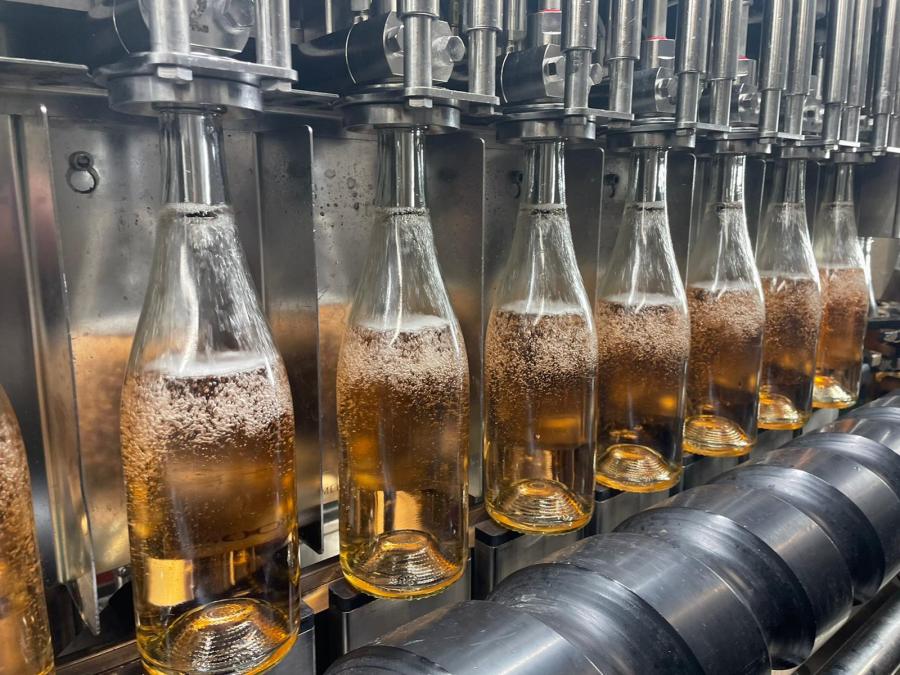Some people view Charmat as the poor cousin of traditional method sparkling wine – even though the quality of the finished product is determined by the quality of the base wine and not the fermentation method. But Charmat also has some key advantages over bottle fermentation.
Packaging flexibility
With Charmat it is easy to respond quickly to market demands, as changes to bottle shape and bottle size can be made much closer to time of sale. Half bottles can be produced economically – and even the dreaded 20cl bottles.
Security of second fermentation
A stuck secondary fermentation in bottle is one of a winemaker’s worst nightmares. It can be expensive, problematic and often irrecoverable. However, with the Charmat method there are many things that can easily be done in tank to prevent this, such as adding nutrients, warming with ease, micro-oxygenation, and even re-inoculating.
Avoiding reduction
Reduction soon after the end of secondary fermentation is a common problem with bottle fermentation. The addition of copper sulphate at tirage can combat this, but generally winemakers avoid this for organoleptic reasons. With tank fermentation it is simple to monitor reduction and then only treat if necessary. Also the copper sulphite formed as a result of any addition will be insoluble – and so easily filtered out prior to bottling – minimising the risk of excess copper in the finished product.
Post-fermentation blending
Although the Charmat tanks are under pressure, blending can still be done post-fermentation, including homogenisation of a large blend, tweaking of style or even modification of colour intensity for a rosé. This is something that is often very difficult to get just right for bottle fermentation.
Risk free cold stabilisation
Tartrate precipitation during secondary fermentation or after disgorging is another major problem for winemakers, causing riddling problems and gushing. Cold stabilisation prior to secondary fermentation has its limitations, as the increase in alcohol level during secondary (around 1.25%) increases instability. However, with Charmat this can be addressed by cold stabilisation post-secondary.
Precision on final pressure
Getting the pressure just right for bottle fermentation can sometimes be a challenge. The conversion of sugar to CO2 (and alcohol) is a biological process and subject to many variables. When fermenting under pressure in a tank, it is easy to vent off any excess pressure to achieve exactly what is required.
Use of β-glucanas enzymes
The benefits of maturation on yeast lees are well known. This can be accelerated not just by battonage but by the addition of β-glucanas enzymes and while not true yeast autolysis, it increases texture and roundness. This has been tried during secondary fermentation in bottle but with problems, as the yeast fragments released do not all settle down so are not removed by riddling and disgorging – resulting in major gushing problems. With tank fermentation this is not a problem as any fragments can easily be filtered prior to bottling.
True microbial stability
With bottle fermented wine it is impossible to remove all microbes at disgorging – there will always be some cells remaining, to a greater or lesser extent. However, with tank fermentation this is not the case as sterile filtration and aseptic bottling is possible.
One implication of this is that wine SO2 levels can be dropped significantly, as a high level is no longer required to inhibit microbial growth. Plus, the winemaker is no longer obligated to doing a malolactic fermentation to avoid problems during riddling.
Minimal dissolved oxygen pickup
Unless the disgorging line is equipped with a jetting unit, dissolved oxygen pickup can be high and also very variable. SO2 in the dosage can go some way towards alleviating this, but the variability will cause a bottle-to-bottle variability in sensory profile. Counter pressure bottling of tank fermented wines is more controllable and it is possible to achieve levels as low as 20ppm. Again, enabling a drop in SO2 levels.
The evolution of sparkling wines came through fermentation in bottle, then development of stronger bottles, ridding and tank fermentation. One cannot help wondering if the technology for Charmat had existed earlier, would bottle fermentation exist today?




